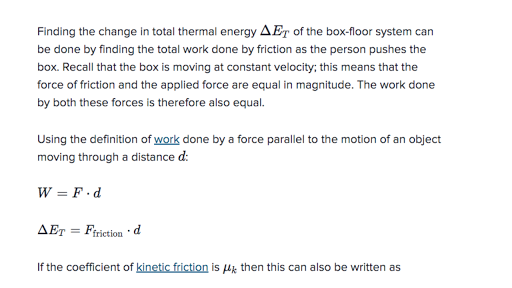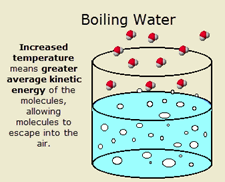How Does Mass Affect Thermal Energy
Thus reducing the heating and cooling demand of the building itself. Place an empty trimmed cup on the mass balance and tare for zero.

Temperaturethermal Energyheat A Measure Of The Average Kinetic Energy Of The Particles In A Substance Degrees Fa Thermal Energy Internal Energy Science Lessons
Thermal mass materials achieve this effect by absorbing heat during periods of high solar insolation and releasing heat when the surrounding air begins to cool.

. 71 of people thought this content was helpful. English 21062019 1630 kingo7. You need to have these in your answer - the mass if the substance - the temperature of the substance is measured - a connection between mass and thermal energy transfer is developed.
Up to 24 cash back The more mass the more thermal energy there is. Where ΔQ Rate of heat transfer kW m Mass flow rate kgs or LPM ΔT Temperature difference in Kelvin. How does mass effect thermal energy.
This is because the amount of mass affects an objects ability to absorb thermal energy. Add water to the cup until the total mass reads 200 g. Temperature affects thermal energy but temperature is not the same as thermal.
Show reviews 1 Back to the top of the page. If two objects have the same mass the object with the highest temperature has more heat energy. The higher the temperature of a given quantity of a substance more is its thermal energy.
How does mass and material type effect thermal energy transfer Answer The mass contributes with the time of thermal energy transfer with respect to the material type but most importantly the material type will determine rate at which the material absorbs the transfer of heat or thermal energy by either three types conduction convection and radiation. The amount of energy a substance gains or loses is related to the amount its temperature changes using the equation Q m c DeltaT where Q is the energy the substance gains m is the mass of material changing temperature c is the specific heat capacity of the substanceand DeltaT is the change in temperature. While observing the thermal energy transfer mass is a crucial factor to look at.
Examining the Effect of Material and Mass on Thermal Energy Transfer Step 2. How does mass flow rate affect heat transfer. So in this model total kinetic energy is used to represent thermal energy.
Materials with high thermal conductivity are known as conductors and material with poor thermal conductivity are known as insulatorsHow does thermal conductivity affect the rate at which thermal energy is transferred. Therefore the thermal energy depends on the mass of the object. Its not just hot things such as the air and sand of Death Valley that have thermal energy.
Think about these relationships and follow the procedure to imagine how temperature and thermal energy are related. The greater the mass of a substance the more thermal energy. The total kinetic energy of moving particles of matter is called thermal energy.
People also ask does mass affect energy. Energy cannot be created out of nothing. Other questions on the subject.
Thermal mass refers to the material inside a building that can help reduce the temperature fluctuations throughout the course of the day. Sensible heat or latent heat transfer the amount of heat transfer depends on mass directly. The fundamental conservation law of the universe is the conservation of mass-energy.
How does mass affect thermal energy. It is sometimes known as the thermal flywheel effect. The thermal energy of a substance depends on the temperature and mass of that substance.
Similarly for the same temperature higher mass of a substance will contain more thermal energy. How does mass affect thermal energy transfer. As you know heat transfer also affecte by the thermal capacity of the material which is nothing but the multiplication of specific heat and mass.
The thermal energy of a substance depends on the temperature and mass of that substance. This means that the total mass and energy before a reaction in a closed system equals the total mass and energy after the reaction. Set up samples to examine thermal energy transfer with varying material and mass.
The greater the mass of a substance the more thermal energy. A Trim off the bottom half of three foam cups. An objects thermal energy is dependent upon its temperature and mass.
Remember that heat energy is the total kinetic energy of all particles in an object. In building design thermal mass is a property of the mass of a building which enables it to store heat providing inertia against temperature fluctuations. For example when outside temperatures are fluctuating throughout the day a large thermal mass within the insulated portion of a house can serve to flatten out the daily.
Up to 24 cash back PART I. You need more energy transfer to raise the temperature of a big mass than you need for a small mass because there is more stuff to heat up there fore if you have twice the mass you need twice the energy transfer to heat up the mass. Different masses will change temperature at different rates when exposed to the same amount of thermal energy.
This is because the amount of mass affects an objects ability to absorb thermal energy. What distinguishes the dialogue of this excerpt most clearly as a work of the postmodern era. Thats because the particles of all matter are in constant motion and have kinetic energy.
Does mass affect thermal energy. All matter has thermal energy even matter that feels cold. Thermal conductivity is the rate at which heat transfers through a material and is characteristic property of a substances.
The relation of mass flow rate and the heat transfer rate is expressed as below ΔQ m Cp ΔT. Mass is the weight or volume or an object and it affects. The heat transfer depends on many factors like temperature difference velocity etc.


No comments for "How Does Mass Affect Thermal Energy"
Post a Comment